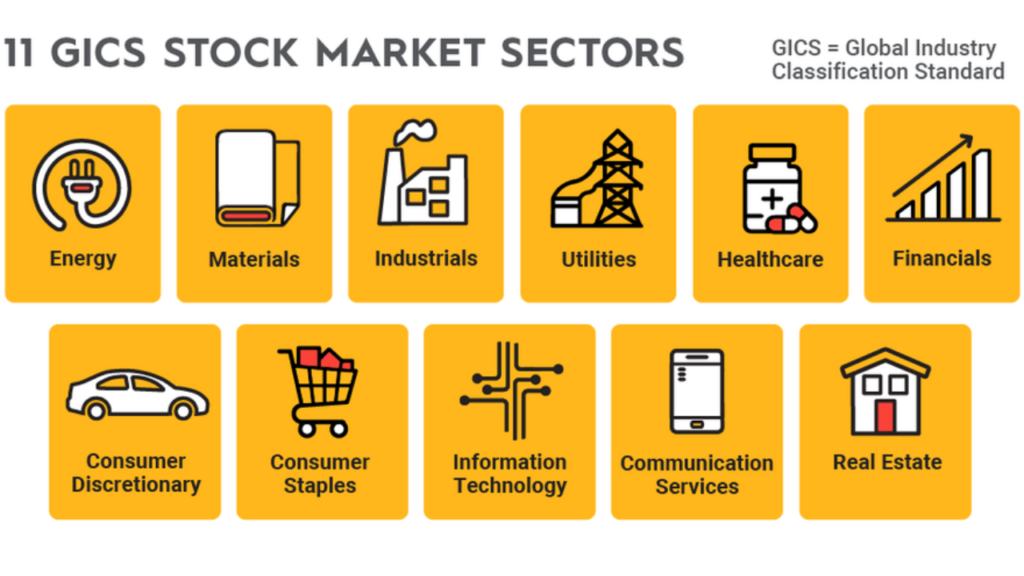set of equities that have several characteristics, typically due to their comparable businesses, is referred to as a stock market sector. The most widely used classification system, the Global Industry Classification Standard (GICS), divides the stock market into 11 distinct sectors.
To facilitate the comparison of businesses with comparable business models, we group stocks into sectors.Comparing the most profitable stocks is also made simpler by sectors.

Investing in stock sectors
At a glance, the 11 GICS stock market sectors are:
- Energy
- Materials
- Industrials
- Utilities
- Healthcare
- Financials
- Consumer Discretionary
- Consumer Staples
- Information Technology
- Communication Services
- Real Estate
Stock Market Trends for 2025: Important Information for Investing
1. Energy sector
Businesses operating in the oil and natural gas sector are included in the energy sector.Companies that explore for and produce oil and gas are included, as are those that make other consumable fuels like coal and ethanol.
The associated companies that supply oil and gas producers with tools, supplies, and services are also included in the energy sector. Many renewable energy companies are not included in it; they are categorized as utilities.
2. Materials sector
The materials sector includes companies that provide various goods for use in manufacturing and other applications. You’ll find makers of chemicals, construction materials, and containers and packaging within the materials sector, along with mining stocks and companies specializing in making paper and forest products.
Well-known materials stocks include paint maker Sherwin-Williams (SHW -0.35%) and chemicals manufacturer DuPont (DD -2.18%).
3. Industrials sector
The industrials sector encompasses a wide range of different businesses that generally involve the use of heavy equipment. Transportation stocks such as airlines, railroads, and logistics companies are found within the industrials sector, as are companies in the aerospace, defense, construction, and engineering industries. Companies making building products, electrical equipment, and machinery also fall into this sector, as do many conglomerates.
UPS (UPS -1.59%) and RTX (RTX -1.57%) are the largest U.S. industrials stocks.
4. Utilities sector
Every possible kind of utility company is included in the utilities industry. The industry includes companies that specialize in natural gas transportation and distribution, as well as utilities that make electricity available to residential and commercial clients. Water delivery to consumers is the responsibility of other utilities. There are utility firms that specialize in multiple subspecialties. Furthermore, although they differ greatly from the conventional regulated utility, independent power producers and renewable electricity also fall under the utilities sector.
5. Healthcare sector
There are two main parts to the healthcare industry. One element consists of businesses that create biotechnology-based medications and treatments, together with the equipment and supplies required for the clinical studies that evaluate those treatments. The other includes surgical supplies, medical diagnostic instruments, health insurance, and other healthcare services and equipment.One especially intriguing area of the healthcare industry that fits into the latter group is telemedicine.
6. Financials sector
Businesses primarily involved in handling money are included in the financials industry.Although banks are a major industrial group in the sector, other financial institutions include brokerage houses, insurance companies, consumer financing providers, and real estate investment trusts associated to mortgages. Some of the most well-known financial technology, or fintech, businesses are also part of the financial sector.
Fintech
Financial technology, or fintech, refers to a range of hardware, software, and app platforms that use technology to simplify, improve, and increase the profitability of financial operations.
7. Consumer discretionary sector
The goods and services in the consumer discretionary sector are those whose demand is influenced by the financial situation of the consumer. For instance, if you earn $25,000 annually, you most likely purchase a different vehicle than someone who earns $25 million annually. The industry comprises businesses that offer luxury goods, expensive goods like cars, and leisure goods. This category includes equities from hotels and restaurants as well as retail businesses with physical locations and online stores.
Amazon (AMZN 0.63%) and McDonald’s (MCD -0.48%) are among the biggest stocks in the sector.
Where to invest $1,000 right now
When our analyst team has a stock tip, it can pay to listen. After all, Stock Advisor’s total average return is 835% — a market-crushing outperformance compared to 164% for the S&P 500.
8. The consumer staples industry
Products and services that people require, irrespective of their financial situation or the state of the economy, are included in the consumer staples category. Companies in the food, beverage, and tobacco sectors as well as those that produce domestic and personal care goods fall under this category. This group also includes grocery stores and other retail businesses that focus on selling necessities.
Coca-Cola (KO -1.62%) and Procter & Gamble (PG -0.57%) are two of the most valuable consumer staples stocks in the U.S. market.
9. Information technology sector
The information technology industry, sometimes known as just the “tech sector,” includes businesses engaged in the various forms of technical innovation. While some IT firms concentrate on developing software or offering services for putting technical solutions like cybersecurity into practice, others are primarily involved in producing the hardware, components, and equipment that enable technology. Manufacturers of semiconductors and the machinery required to create semiconductor chips are also included in the category of information technology.
Apple (AAPL 1.95%) and Nvidia (NVDA -0.75%) have been switching places at the top of the list of large U.S. stocks in the information technology sector.
10. Communication services sector
Among the newest of the GICS sectors, the communication services sector encompasses a few key areas that were previously part of other sectors.One wing of the industry is made up of providers of telecommunication services. Media and entertainment companies are at the other end of the spectrum, encompassing both newer kinds of communication and interactive media through the internet, as well as more traditional media like radio and television.
Social media giant Meta (META 1.69%) and search engine pioneer Alphabet (GOOG 0.76%L) (GOOG 0.76%) are among the biggest stocks in communication services.
11. Real estate sector
Formerly a part of the banking industry, the real estate sector is the newest GICS sector. In general, it encompasses two distinct categories of real estate investments. Developing new real estate projects and managing them by finding tenants for different spaces inside the project property are the responsibilities of certain stocks in the sector. Furthermore, the real estate sector includes the majority of real estate investment trusts, or REITs (pronounced REETS), which are unique tax-favored corporate organizations that function in several real estate-related sectors.
Among the top stocks in the real estate sector, you’ll find cellular communications tower specialist American Tower (AMT 0.86%) and major shopping mall owner and operator Simon Property Group (SPG -1.41%).
you may be interested in this blog here:




